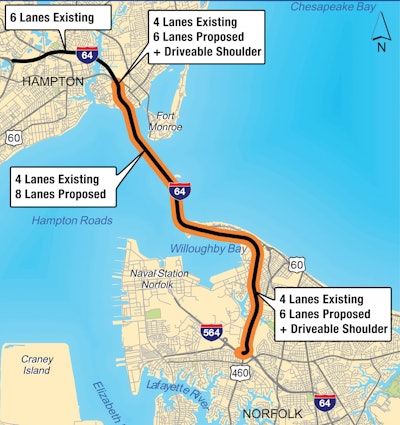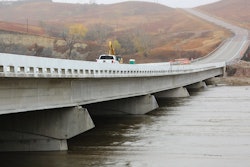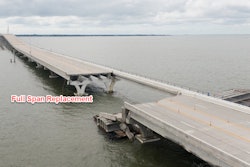 The Hampton Roads Bridge Tunnel. Photo credit: Virginia DOT
The Hampton Roads Bridge Tunnel. Photo credit: Virginia DOTConstruction is set to begin on the largest infrastructure project in Virginia’s history.
The $3.8 billion Hampton Roads Bridge-Tunnel Expansion Project will use a tunnel boring machine for the underwater part of the 9.9-mile expansion of Interstate 64 between Hampton and Norfolk. The boring machine is being built in Germany and is expected to arrive next year in Hampton Roads for assembly, according to the Virginia Department of Transportation. The agency says tunneling is scheduled to begin in 2022.
Two tunnels will be constructed, each carrying two lanes. They will be built west of the existing eastbound tunnel. When completed, the new tunnels will provide four lanes of eastbound traffic, and the existing tunnels will handle four lanes for westbound drivers. The project also involves widening sections of I-64 to and from the tunnels from four to six lanes. More than 24 bridge structures along the route will be replaced or rebuilt, including the approach spans between the islands and the shorelines.
According to VDOT, the new tunnels will be 45 feet in diameter, making them the second-largest tunnel opening for a tunnel boring machine in North America. The largest, at 57.5 feet, was created by boring machine Bertha for Seattle’s State Route 99 tunnel.
 Hampton Road Tunnel map. Credit: Virginia DOT
Hampton Road Tunnel map. Credit: Virginia DOTThe tunnels will extend 8,000 feet across the Hampton Roads Waterway and be about 50 feet deeper than the current tunnels that are 7,500 feet long. The tunnels connect to artificial islands that have trestle bridges to shore. The first tunnel was constructed in 1957 and was the first crossing built between manmade islands, according to VDOT. The second tunnel was added in 1976.
The agency says 100,000 vehicles travel the tunnels each day, making it the region’s most congested corridor. During summer tourist season, traffic backs up as much as six miles at times, VDOT says.
Along with easing congestion, the project is expected to increase safety, improve emergency evacuations for hurricanes, create 28,000 jobs and add $4.6 billion in investment.
“This is the largest project in our history, and it will ensure that people can move around faster, that commerce flows more easily, and that we finally connect the Peninsula and the Southside,” said Gov. Ralph Northam at the groundbreaking ceremony October 29.
The design-build contractor for the project is a joint venture of Dragados USA, Vinci Construction, Flatiron Constructors and Dodin Campenon Bernard. The designers for the Hampton Roads Connector Partners team are HDR and Mott MacDonald.
Work has started on the land part of the project. The project is expected to be completed in November 2025.
Crews have also been preparing for the boring machine by moving utility lines, building temporary plants and a dock to receive the machine.
The boring machine is designed to alternate between excavating and installing precast tunnel segments as it travels under the waterway.
A video below by the VDOT explains the process:













